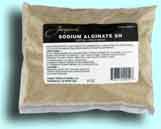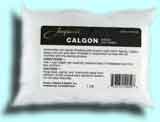ADVERTISEMENTS
You are here: Home > All About Hand Dyeing > FAQ > auxilliary chemicals > dye thickeners
ADVERTISEMENTS
Thickeners can be added to dye to give it a good consistency for painting. They are also popular in tie-dyeing for improving the crispness of a design. The use of a thickener may also increase the brightness of colors by aiding in holding the dye in the fabric for the dye reaction to occur.
Different thickeners used in dyeing and discharge include sodium alginate, Superclear, monagum, and other polysaccharides.

Sodium alginate is the most popular of the dye thickeners and may be purchased from any good dye supplier by mail order; see Sources for Dyeing Supplies for a list of different dye supply companies. Alginate is extracted from brown algae, a type of seaweed. Different lots of sodium alginate will be more or less thick than previous lots, so you must experiment to see how much you need to use.
Alginate tends to clump horribly when water is added. I've had good experiences by adding the alginate to cool water gradually, while whisking constantly with a small stainless steel whisk.
If that doesn't work for you, here are two different answers to the problem. One is to mix the alginate the day before use, using a kitchen blender.

The other answer to the problem of dissolving alginate is to mix the alginate with either alcohol or corn oil before adding the water, so that the particles will be separate and not stick together when water hits them. An added advantage to the use of alcohol or vegetable oil is that the solutions are said to stay good much longer than those prepared with water alone.
The alcohol you use to mix your alginate with before adding water can be denatured alcohol, also known as methylated spirits, or it can be isopropyl alcohol, also known as rubbing alcohol. Corn oil has also been used successfully for this purpose; any refined, tasteless vegetable oil should work as well. The goal is just to separate the particles of the alginate before adding any water.
Another problem with alginate is that a dye solution made using it, or a stock solution of alginate, may sometimes form a semisolid gel, which is undesirable and difficult to get out of dye bottles. Unlike gelatin or agar, alginate gels do not melt when heated. The gel is caused by the presence of calcium ions, which are common in water and may be contaminants in other ingredients.
 The answer is to use soft or distilled water or to include a particular water softener chemical, sodium hexametaphosphate, in your mixture. Use 1 teaspoon (5 ml, or 7 grams) of of metaphos per quart (or liter) of water. Calgon brand laundry water softener may be substituted only if it is not phosphate-free; the old powder form of Calgon, also known as Calgon T, was sodium hexametaphosphate, which is ideal, but the phosphate-free liquid version of Calgon, containing polycarboxylate, should not be used in dyeing. Jacquard's Calgon, Dharma's Water Softener, and ProChem's Metaphos are all fine.
The answer is to use soft or distilled water or to include a particular water softener chemical, sodium hexametaphosphate, in your mixture. Use 1 teaspoon (5 ml, or 7 grams) of of metaphos per quart (or liter) of water. Calgon brand laundry water softener may be substituted only if it is not phosphate-free; the old powder form of Calgon, also known as Calgon T, was sodium hexametaphosphate, which is ideal, but the phosphate-free liquid version of Calgon, containing polycarboxylate, should not be used in dyeing. Jacquard's Calgon, Dharma's Water Softener, and ProChem's Metaphos are all fine.
Typically two different grades of alginate are used for dyeing. The low viscosity/high solids form is preferred for fine details on silk or wool, while the high viscosity/low solids form is preferred for cotton; the latter may also be used on silk when fine detail is not needed.
This is Michael Fowler's recipe for tie-dyeing [from a post on the old Fiber-Arts Forum]....
Here's a recipe for using alcohol to prepare alginate....
Superclear was reformulated in 2013, after manufacturing shortages made it impossible to find. The new formulation, carried by Dharma Trading Company, should be used only with distilled water or with water that has been treated with sodium hexametaphosphate (water softener). Dharma warns that it can be difficult or impossible to remove after extended steaming. I suggest that you test before using it in a large or important project.
There used to be two different though similar products sold under the name of Superclear, one available from Jacquard Products and one from Dharma Trading Company. like the current formulation, their advantage was that, as they were already liquid, there was none of the inconvenience that is found in dissolving alginate. They also used to lack the distressing tendency of alginate to gel in the presence of calcium ions, but this might not be the case for the new formulation. Otherwise, the disadvantage of Superclear is that it is more expensive and costs more to ship, as well.
Dharma says,
" **Attention - this product is a new formulation. We bought the last of the old product and the manufacturer can no longer get the ingredients. They sent us samples of several alternatives, and we finally got one that would work, is safe to use, and works as close to the way the original worked as possible.
"Use this gel to thicken liquid dye solutions when applying dye directly onto the fabric, as in stenciling, painting or printing. You can even add a little to your tie-dye solutions to control the bleed of the dye and have crisper lines. Superclear rinses away during the washing out of the dyes. You will have to adjust the following formulas to your situation, i.e. it's kind of like cooking, use to taste, except, don't taste it! NOTE: Can be difficult or impossible to remove after extended steaming, especially if you have hard water. Using distilled water, both to mix your dyes and in the steaming, works better.
"To reduce spreading - add 4 or more tablespoons to 8 oz. of liquid dye concentrate
To stop spreading - use 2/3 Superclear and 1/3 liquid dye concentrate
To make Fiber reactive dyes into a paint- add the dye powder to a mix of 2/3 or more Superclear and 1/3 or less water."
Monagum is, according to PRO Chemical & Dye, a modified starch gum that is the only thickener for discharge printing with hypochlorite ("chlorine") bleach that stays thick, rather than breaking down and becoming thin quite soon after mixing with the bleach. We do not use it to thicken reactive dyes.
Starch, a polysaccharide which is used as a thickener in foods, is not used with reactive dyes. This is because the starch will itself react with the dye, resulting in lower color yields; dyed starch may also loosely bind to the fiber, washing out only gradually over the course of many washings and making it appear as though the dyed fabric is not washfast. In theory, starch could be used with acid dyes, but I have never seen this recommended.
Methyl cellulose is a thickener commonly used for marbling. The water is thickened with methyl cellulose so that it will support fabric paint which is floated on top of it.
Methyl cellulose can also be used to make print paste for acid dyes. You might be able to find it in a specialty wallpaper shop under the name of 'cellulose adhesive.'
Guar gum is another thickener that is commonly used (in more purified form) in foods. It is used to thicken the caustic paste used to make devoré patterns on mixed fibers. It is not used with fiber reactive dyes such as Procion MX because it reacts with them, competing with the fiber that is being dyed, but it is used to thicken vat dyes and acid dyes. See ProChem's recipe for Colored Discharge Printing using PRO Vat Dyes. Guar gum is superior to alginate in thickening Lanaset dyes.
PRO Chemical & Dye sells two convenient sodium alginate mixtures, PRO Print Paste Mix F and PRO Print Paste Mix SH. Pro Print Paste F (for silk) contains urea, low viscosity alginate and metaphos, while Pro Print Paste SH (for cotton) contains urea, high viscosity alginate and metaphos. (Metaphos is ProChem's name for the water softener, sodium hexametaphosphate).
Last updated: March 7, 2010
Page created: June 21, 2006
Downloaded: Wednesday, August 27, 2025
All of the pages on this site are copyright ©1998‑2025 Paula E. Burch, Ph.D.